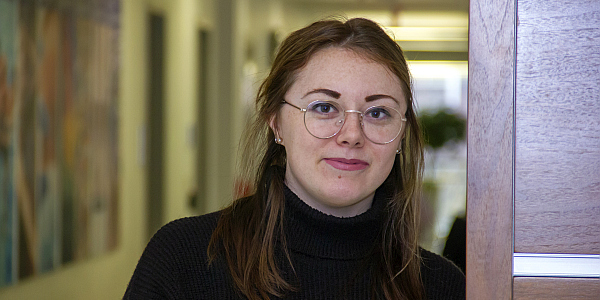
Kayleigh Adamson (BIOST MS '20) is from Crawford County in Northwestern Pennsylvania. With about 60 people in her graduating class, she grew up a self-described rural country girl. She started college at Penn State Behrend in Erie, PA, transferring to main campus for her junior and senior years. At Penn State, she studied neuropsychology while minoring in both biology and sexuality and gender studies. Plus getting a certificate in crime psychology and public policy. “It was a nice smorgasbord,” she said.
Adamson has always been on a path to study science. While still in high school, she took a college course in psychology and it suited her. She wanted to understand human behavior and emotion. She needed a heavier science to pair it with. Thus, neuropsychology.
Adamson had a good amount of research lab experience already when she got to Pitt Public Health. She’d worked in various labs while she was an undergraduate student, and after she graduated, she worked for three years at Geisinger’s Autism and Developmental Medicine Institute, using neuroimaging as a tool to understand how the brain works in children with autism. Eventually, her mentor, Vanessa Troiani, began to work on opioid use disorder. “Geisinger is a really great place because we have 15 years of electronic health data so we have a really rich database there. We started utilizing that and she got a really big grant from the NIH.” This was fortuitous for Adamson for two reasons – it was both her lead in to big data and it’s what got her into opioid research.
Adamson has found that many of the people she has met at Pitt Public Health have had similar paths, only in that they are “not a straight line” into their discipline. And you do hear that a lot here - that people didn’t have a “traditional” path into their field. At the same time, Adamson’s path to the Department of Biostatistics at Pitt seems kind of perfect.
While at Geisinger, Adamson was talking to Troiani about what was next in her career. She had originally been planning a PhD in cognitive psychology. Troiani suggested Adamson ought to combine her strong analytical skills with her love of science. “Have you ever heard of biostatistics?” her boss asked. She had heard of it, but that was about it. She’d never considered it before and didn’t know a lot about it. She started looking into it right away, contacting Pitt Public Health’s Ada Youk the next day. They discussed her background and interests. Adamson wasn’t sure that she had the prerequisites required to apply and be successful in the program but Youk said she’d be a good fit. And while a strong math background certainly doesn’t hurt, it’s not a metric for success.
“With the more theoretical perspective of biostatistics, it could be more difficult [for non-math majors] but the department helps you so much that you just utilize your resources and get there,” said Adamson. “It was off to the races after that – it was crazy.”
That’s not to say that she didn’t consider other programs – she did, but Pitt was an attractive option for many reasons. It’s close to home and has the huge UPMC hospital system boasting a wealth of opportunities for health science academics. The program seemed right for her and we have a strong presence studying opioids. Plus, it’s in Pittsburgh. “I love Pittsburgh. It’s a really nice city to be in. It’s affordable, this just seemed like the best fit for me. So luckily I got in!”
It was the right fit. Her time here has been great. “I love my cohort – my cohort is really incredible. We went to a pumpkin patch last weekend. It was really cute. I really enjoy that. I also just enjoy the opportunities and the faculty in our department. Graduate school is not easy, nor is it supposed to be, but the faculty are just so devoted to making you succeed and really making you feel that you have a partner here. I love the breadth of courses that you can take.”
Adamson stays plenty busy. She’s the secretary of the Pittsburgh ASA Student Chapter as well as serving the Department of Biostatistics as both the departmental representative and one of two departmental ambassadors. She volunteers for Prevention Point Pittsburgh, and next month she’ll be starting as a volunteer with the Carnegie Science Center’s Mentors in the Making program. She’s also a TA with Jenna Carlson. To relax, she likes to watch golden age films with her neighbors. They project them on their porch. Most recently, they watched Rocky Horror Picture Show.
As one of two student ambassadors, Adamson tries to be a good face for the department. She recommends biostatistics at Pitt by telling new applicants what she loves about it and spreading the word on all the opportunities available to students. She and Ruishen Lyu, the other ambassador this year, also act as sounding boards for the students. If there is something her peers want to improve upon, they can come to her and Lyu.
Adamson is nurturing her passion for big data and the opioid epidemic remains her main research area. This summer, she worked with Eric Hulsey (BCHS ’08) at the Allegheny County Department of Human Services in the Analytics, Technology, and Planning division looking at opioid overdose data in Allegheny County between 2008 and 2018. When she graduates this spring, she’s already been hired to work as a data analyst here with BIOST’s Jeanine Buchanich via Opioid to Action. She’s excited to work on evaluating the prescription drug monitoring program.
12/09/2019